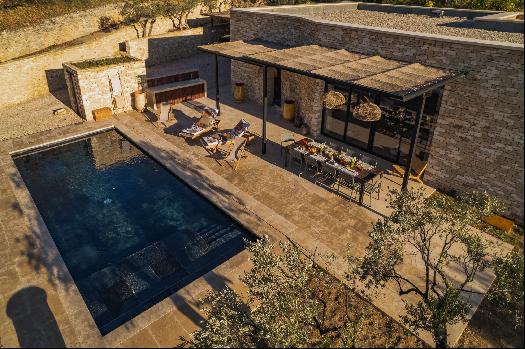
By Elsa Court
Focus on sustainability
Before installing big ticket sustainable energy sources such as solar panels or a wind turbine, ensure the shell of your home is as green as possible, says Harry Paticas, director of Arboreal Architecture, a London-based practice specialising in retrofitting.
Paticas recommends including heat loss measures when planning refurbishments or repairs. “Phasing retrofit can be a more economically viable option for many people,” he says. “For example, if you need to install a new kitchen or carry out repairs to the roof, these are excellent opportunities to insulate the walls or install a ventilation system and thus lock in low carbon performance.”
This will not only save on energy bills, Paticas says, but boost comfort and health. “Simple measures such as filtering ventilation systems or triple-glazed windows not only reduce heat loss but make for a healthier home, respectively, in terms of reducing humidity levels and acoustic pollution,” he adds.
This three-bedroom apartment in central Toulouse, France, combines traditional Haussmannien features such as high ceilings and parquet floors with retrofitted triple-glazed windows. It is on the market for €780,000.

Adopt a flexible layout
Remote working and home schooling during Coronavirus lockdowns and beyond have focused minds on adapting living spaces for different uses.
“If planning renovations in order to future-proof an existing home, the first step is always to look at the space you do have,” says Vicky Saunders of BTP Architects in northern England. For example, could you free up space taken by an existing kitchen or bathroom by choosing smaller units?
You can then consider flexible ways of dividing space. “A kitchen counter can work efficiently as a breakfast counter and computer station, if you can route in the plugs,” says Saunders. While moveable walls are best integrated into new builds, she says existing homes can benefit from foldable screens, furniture with built-in partitions and acoustic barriers.
This four-bedroom loft in San Francisco uses a combination of moveable walls and partitions to separate two office spaces from the main living room area as required. Decorative sliding doors on the wall of the guest suite open to reveal a large TV. It is available for $4.75m.

Stay connected
With tech increasingly woven into the fabric of the home, reliable WiFi is a future-proofing must-have. Damien Krklinski, director of Ryda Tech, a San Francisco-based IT consultancy, recommends a mesh WiFi system to eliminate patchy coverage. “In an age when lights, thermostats, security systems, surveillance cameras and even refrigerators in our homes depend on a reliable internet connection, a mesh WiFi system is the best solution,” he says.
The basic mesh set up involves plugging mini routers called nodes into power sockets around the home — each node provides WiFi coverage, but they communicate with each other to work as a single network — to boost the connection throughout. For even greater reliability, Krklinksi advises installing data points. Similar in appearance to landline sockets, plugging the nodes into them provides a direct wired connection to the router.
This two-bedroom apartment in London’s Chelsea has data points to ensure a reliable network connection throughout the property. It could be yours for £5.75m.

Design with the local climate in mind
Work with the local climate when designing a garden. Catriona Glanville, founder of Outscape, a landscaping consultancy based in New South Wales, Australia, advises that for inland properties in Australia, for example, this means planting for dry conditions.
“I always advise clients to do without a European-style lawn if they don’t need it,” she says. “Many people think a green lawn will bring cool air to their property in the summer but that’s a myth.”
While you might think that native species are the sustainable pick, Glanville says this is not always so. “I would recommend a mix,” she says. “If you combine native species and Mediterranean-style plants you have a higher chance of your garden thriving overall amid dry summers and the occasional wet winter.”
The evergreens and deciduous plants, including Himalayan cedars, in the garden of this property in Burradoo, New South Wales, require little water and pruning. The 1.6 acre-plot includes a natural spring and rainwater tank, while the house has three bedrooms and a price of A$5.9m ($4.3m).

Research renovations
Property value depends greatly on what buyers in your location want, so factor that into any home improvements to keep your home current. For example, estate agent Ashley Barnes of Greeff Properties in Cape Town says that owners of large historic estates in her area have done well by dividing them up into smaller lots with broader market appeal.
The most successful renovations, she adds, retain a property’s original character. “Always talk to an architect, designer and landscape expert first, who will know how to renovate a heritage property while being mindful of its character,” she says. “Buyers are sensitive to the soul of a property when making their first impression, regardless of the specifics of what they are looking for.”
If you are thinking of altering the layout, Barnes recommends locating all bedrooms on the same floor, which makes it easier to sell the property as a family home. “Think of making room for an open plan kitchen to give the property potential for entertaining and family gatherings,” she adds.
This family home in Constantia (also main picture), a Cape Town suburb, has a large open-plan kitchen and reception area. Its five bedrooms enjoy views over the surrounding valley, mountains and seafront. It is on the market for R49m ($2.76m).

Photographs: Christie’s International Real Estate; Mayfair International Realty; Open Homes Photography; Strutt & Parker; Sotheby’s International Realty





















